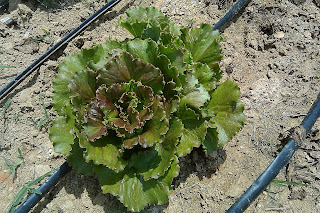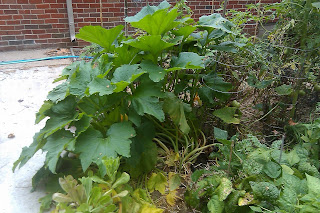The hoop house, a sort of open-sided green house, is bursting with ornamental cock's combs right now. Cock's combs are in the genus Celosia, and they come in amazing colors: eye-searing red, blazing peach with yellow, glowing whitish-green and orange. They are such shockingly bright colors due to the fact that they are fluorescent. Fluorescent colors absorb light energy from outside the visible spectrum (like UV light) and then emit that UV light as visible light...so they do actually glow. Fluorescence is most noticeable when visible lights are turned off and black lights are shined, but cock's combs are so fluorescent that you notice them in full sunlight.
 |
| Hoop house full of Celosias. |
 |
| A Celosia close-up. It's even brighter in real life. |
The fluorescence of cock's combs is useful for the plant - it attracts pollinators. In the hoop house, the peach cock's combs were the hands-down favorite of bees and wasps. Each plant was swarmed with pollinators large and small. The peach sector of the hoop house was buzzing, audibly as well as visually, with insect activity. Good thing I got over my giant ground hornet fear in the previous post.
 |
| Peach Celosia, source. |
Amaranths in the U.S. are herbs, though there are some tropical shrubs. They have tiny flowers, usually clustered all together. The flower parts are so tiny, they are best seen with a hand lens or dissecting microscope. Other ornamental amaranths include Gomphrena and Iresine. Edible amaranth, genus Amaranthus, is used as a grain. It is an important high-protein cereal native to South America. Weedy pigweeds, in the same genus as edible amaranth, are found here in the U. S., and though their seeds and leaves are edible, it is much more of a nuisance than a valued crop.
On the farm, half of our interactions with amaranths involve planting and harvesting the Celosias and Gomphrenas and the other half are killing the pigweeds, spiny amaranths and escapees from last year's crops. The escaped plants from last year are seeds that have fallen and overwintered in the soil. They are usually crosses between different types of Celosias, so they have a blend of their parents' traits. That means they might have unpredictable colors, small flower heads and irregular growth forms. They don't usually make good cut flowers, and they have to be treated as regular weeds.
 |
| An escaped and hybridized Celosia from last year's crop growing among the zinnias. |


























